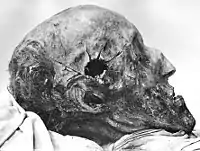Charles XII of Sweden
Charles XII, sometimes Carl XII (Swedish: Karl XII) or Carolus Rex (17 June 1682 – 30 November 1718 O.S.[1]), was the King of Sweden from 1697 to 1718. He belonged to the House of Palatinate-Zweibrücken, a branch line of the House of Wittelsbach. Charles was the only surviving son of Charles XI and Ulrika Eleonora the Elder. He assumed power, after a seven-month caretaker government, at the age of fifteen.[2]
| Charles XII | |
|---|---|
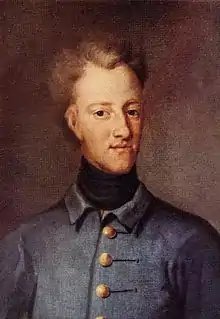 Portrait by David Krafft, 1706 | |
| King of Sweden | |
| Reign | 5 April 1697 – 30 November 1718 O.S.[1] |
| Coronation | 14 December 1697 |
| Predecessor | Charles XI |
| Successor | Ulrika Eleonora |
| Born | 17 June 1682 Tre Kronor, Sweden |
| Died | 30 November 1718 (aged 36)[1] Fredrikshald, Norway |
| Burial | 26 February 1719 Riddarholmen Church, Stockholm |
| House | Palatinate-Zweibrücken |
| Father | Charles XI of Sweden |
| Mother | Ulrika Eleonora of Denmark |
| Religion | Lutheran |
| Signature | |
In 1700, a triple alliance of Denmark–Norway, Saxony–Poland–Lithuania and Russia launched a threefold attack on the Swedish protectorate of Holstein-Gottorp and provinces of Livonia and Ingria, aiming to draw advantage as the Swedish Empire was unaligned and ruled by a young and inexperienced king, thus initiating the Great Northern War. Leading the Swedish army against the alliance Charles won multiple victories despite being usually significantly outnumbered. A major victory over a Russian army some three times the size in 1700 at the Battle of Narva compelled Peter the Great to sue for peace which Charles then rejected. By 1706 Charles, now 24 years old, had forced all of his foes into submission including, in that year, a decisively devastating victory by Swedish forces under general Carl Gustav Rehnskiöld over a combined army of Saxony and Russia at the Battle of Fraustadt. Russia was now the sole remaining hostile power.
Charles' subsequent march on Moscow met with initial success as victory followed victory, the most significant of which was the Battle of Holowczyn where the smaller Swedish army routed a Russian army twice the size. The campaign ended with disaster when the Swedish army suffered heavy losses to a Russian force more than twice its size at Poltava. Charles had been incapacitated by a wound prior to the battle, rendering him unable to take command. The defeat was followed by the Surrender at Perevolochna. Charles spent the following years in exile in the Ottoman Empire before returning to lead an assault on Norway, trying to evict the Danish king from the war once more in order to aim all his forces at the Russians. Two campaigns met with frustration and ultimate failure, concluding with his death at the Siege of Fredriksten in 1718. At the time, most of the Swedish Empire was under foreign military occupation, though Sweden itself was still free. This situation was later formalized, albeit moderated in the subsequent Treaty of Nystad. The result was the end of the Swedish Empire, and also of its effectively organized absolute monarchy and war machine, commencing a parliamentary government unique for continental Europe, which would last for half a century until royal autocracy was restored by Gustav III.[3]
Charles was an exceptionally skilled military leader and tactician as well as an able politician, credited with introducing important tax and legal reforms. As for his famous reluctance towards peace efforts, he is quoted by Voltaire as saying upon the outbreak of the war; "I have resolved never to start an unjust war but never to end a legitimate one except by defeating my enemies". With the war consuming more than half his life and nearly all his reign, he never married and fathered no children. He was succeeded by his sister Ulrika Eleonora, who in turn was coerced to hand over all substantial powers to the Riksdag of the Estates and opted to surrender the throne to her husband, who became King Frederick I of Sweden.[4]
Royal title
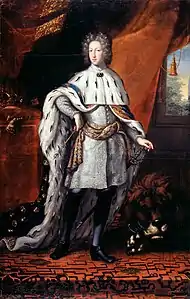
Charles, like all kings, was styled by a royal title, which combined all his titles into one single phrase. This was:
We Charles, by the Grace of God King of Sweden, the Goths and the Vends, Grand Prince of Finland, Duke of Scania, Estonia, Livonia and Karelia, Lord of Ingria, Duke of Bremen, Verden and Pomerania, Prince of Rügen and Lord of Wismar, and also Count Palatine by the Rhine, Duke in Bavaria, Count of Zweibrücken–Kleeburg, as well as Duke of Jülich, Cleve and Berg, Count of Veldenz, Spanheim and Ravensberg and Lord of Ravenstein.[5]
The fact that Charles was crowned as Charles XII does not mean that he was the 12th king of Sweden by that name. Swedish kings Erik XIV (1560–1568) and Charles IX (1604–1611) gave themselves numerals after studying a mythological history of Sweden. He was actually the 6th King Charles.[6] The non-mathematical numbering tradition continues with the current King of Sweden, Carl XVI Gustaf, being counted as the equivalent of Charles XVI.
Great Northern War
Early campaigns
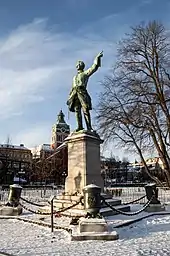
Around 1700, the monarchs of Denmark–Norway, Saxony (ruled by elector August II of Poland, who was also the king of Poland-Lithuania) and Russia united in an alliance against Sweden, largely through the efforts of Johann Reinhold Patkul, a Livonian nobleman who turned traitor when the "great reduction" of Charles XI in 1680 stripped much of the nobility of lands and properties. In late 1699 Charles sent a minor detachment to reinforce his brother-in-law Duke Frederick IV of Holstein-Gottorp, who was attacked by Danish forces the following year. A Saxon army simultaneously invaded Swedish Livonia and in February 1700 surrounded Riga, the most populous city of the Swedish Empire. Russia also declared war (August 1700), but stopped short of an attack on Swedish Ingria until September 1700.[8]
Charles's first campaign was against Denmark–Norway, ruled by his cousin Frederick IV of Denmark, For this campaign Charles secured the support of England and the Netherlands, both maritime powers concerned with Denmark's threats to close the Sound. Leading a force of 8,000 and 43 ships in an invasion of Zealand, Charles rapidly compelled the Danes to submit to the Peace of Travendal in August 1700, which indemnified Holstein.[9] Having forced Denmark–Norway to make peace within months, King Charles turned his attention upon the two other powerful neighbors, King August II (cousin to both Charles XII and Frederick IV of Denmark–Norway) and Peter the Great of Russia, who also had entered the war against him, ironically on the same day that Denmark came to terms.[8]
Russia had opened their part of the war by invading the Swedish-held territories of Livonia and Estonia. Charles countered this by attacking the Russian besiegers at the Battle of Narva (November 1700). The Russians outnumbered the Swedish army of ten thousand men by almost four to one. Charles attacked under cover of a blizzard, effectively split the Russian army in two and won the battle. Many of Peter's troops who fled the battlefield drowned in the Narva River. The total number of Russian fatalities reached about 10,000 at the end of the battle, while the Swedish forces lost 667 men.[10]
Charles did not pursue the Russian army. Instead, he turned against Poland-Lithuania, which was formally neutral at this point, thereby disregarding Polish negotiation proposals supported by the Swedish parliament. Charles defeated the Polish king Augustus II and his Saxon allies at the Battle of Kliszow in 1702 and captured many cities of the Commonwealth. After the deposition of Augustus as king of the Polish–Lithuanian Commonwealth, Charles XII put Stanisław Leszczyński as his puppet on the Polish throne (1704).[11]
Russian resurgence
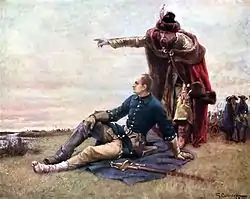
While Charles won several decisive battles in the Commonwealth and ultimately secured the coronation of his ally Stanisław Leszczyński and the surrender of Saxony, the Russian Tsar Peter the Great embarked on a military reform plan that improved the Russian army, using the effectively organized Swedes and other European standards for role models. Russian forces managed to penetrate Ingria and established a new city, Saint Petersburg, there. Charles planned an invasion of the Russian heartland, allying himself with Ivan Mazepa, Hetman of the Ukrainian Cossacks. The size of the invading Swedish army was peeled off as Charles left Leszczyński with some 24,000 German and Polish troops, departing eastwards from Saxony in late 1707 with some 35,000 men, adding a further 12,500 under Adam Ludwig Lewenhaupt marching from Livonia. Charles left the homeland with a defense of approximately 28,800 men, with a further 14,000 in Swedish Finland as well as further garrisons in the Baltic and German provinces.[12][13]
After securing his "favorite" victory in the Battle of Holowczyn, despite being outnumbered over three to one against the new Russian army, Charles opted to march eastwards on Moscow rather than try to seize Saint Petersburg, founded from the Swedish town of Nyenskans five years earlier.[14] Peter the Great managed, however, to ambush Lewenhaupt's army at Lesnaya before Charles could combine his forces, thus losing valuable supplies, artillery and half of Lewenhaupt's men. Charles' Polish ally, Stanisław Leszczyński, was facing internal problems of his own. Charles expected the support of a massive Cossack rebellion led by Mazepa in Ukraine, with estimates suggesting Mazepa of being able to muster some 40,000 troops, but the Russians subjugated the rebellion and destroyed its capital Baturin before the arrival of the Swedish troops. The harsh climate took its toll as well, as Charles marched his troops for winter camp in Ukraine.[15]
By the time of the decisive Battle of Poltava, Charles had been wounded, one-third of his infantry was dead, and his supply train was destroyed. The king was incapacitated by a coma resulting from his injuries and was unable to lead the Swedish forces. With the numbers of Charles' army reduced to some 23,000, with several wounded and handling the siege of Poltava, his general Carl Gustav Rehnskiöld had a clearly inferior force to face the fortified and modernized army of Tsar Peter, with some 45,000 men.[16] The Swedish assault ended in disaster, and the king fled with a small entourage south to the Ottoman Empire, where he set up camp at Bender with some 1,000 of his Caroleans ("Karoliner" in Swedish). The remainder of the army surrendered days later at Perevolochna under Lewenhaupt's command, most of them (including Lewenhaupt himself) spending the rest of their days in Russian captivity.
The Swedish defeat at Poltava in 1709 marks the downfall of the Swedish Empire,[17] as well as the founding of the Russian Empire.[18]
Exile in the Ottoman Empire

The Ottomans initially welcomed the Swedish king, where he went to Abdurrahman Pasha, the commander of the Özü Castle, as he was about to fall into the hands of the Russian army, and he was able to take refuge in the castle at the last moment. Afterwards, he settled in Bender at the invitation of its governor, Yusuf Pasha.
In the meantime, Charles sent Stanislaw Poniatowski and Thomas Funck as his messengers to Constantinople.[19] They managed to indirectly contact with Gülnuş Sultan, mother of Sultan Ahmed III, who became intrigued by Charles, in which she took an interest in his cause, and even corresponded with him in Bender.[19]
His expenses during his long stay in the Ottoman Empire were covered by the Ottoman state budget, as part of the fixed assets (Demirbaş in Turkish), hence his nickname Demirbaş Şarl (Fixed Asset Charles) in Turkey.[lower-alpha 1]
Eventually, a small village named Karlstad (Varnița) had to be built near Bender to accommodate the ever-growing Swedish population there. Sultan Ahmet III, as a gesture to the King, had bought some of the Swedish women and children put up for sale by the Russians and turned them over to the Swedes, thus further strengthening the growing community of Caroleans.[21]
Gülnuş Sultan convinced her son to declare war against Russia, as she thought that Charles was a man worth taking a risk for. Later on, the Ottomans and Russians signed the Treaty of the Pruth and Treaty of Adrianople to end the hostilities between them. The treaties dissatisfied pro-war party, supported by King Charles and Stanislaw Poniatowski who failed to reignite the conflict.
However, the sultan Ahmed III's subjects in the empire eventually got tired of Charles' scheming. His entourage also accumulated huge amounts of debts with Bender merchants. Eventually, "crowds" of townspeople attacked the Swedish colony at Bender and Charles had to defend himself against the mobs and the Ottoman Janissaries involved. This uprising was called "kalabalık" (Turkish for crowd) which afterwards found a place in Swedish lexicon referring to a ruckus. The Janissaries did not shoot Charles during the skirmish at Bender, but captured him and put him under house-arrest at Dimetoka (nowadays Didimoticho) and Constantinople. During his semi-imprisonment the King played chess and studied the Ottoman Navy and the naval architecture of the Ottoman galleons. His sketches and designs eventually led to the famous Swedish war ships Jarramas (Yaramaz) and Jilderim (Yıldırım).
Meanwhile, Russia and Poland regained and expanded their borders. Great Britain, an adversary of Sweden, defected from its alliance obligations while Prussia attacked Swedish holdings in Germany. Russia occupied Finland (the Greater Wrath 1713–1721). After defeats of the Swedish army, consisting mainly of Finnish troops in the Battle of Pälkäne 1713 and the Battle of Storkyro 1714, the military, administration and clergymen escaped from Finland, which fell under Russian military regime.[22]
During his five-year stay in the Ottoman Empire, Charles XII corresponded with his sister (and eventual successor), Ulrika Eleonora. According to Mrs. Ragnhild Marie Hatton, a Norwegian-British historian, in some of those letters Charles expressed his desire for a peace treaty which would be defensible in the future Swedish generations' eyes. However, he emphasized that only a greater respect for Sweden in Europe would enable him to achieve such a peace treaty. Meanwhile, the Swedish Council of State (government) and Estates/Diet (Parliament) tried to keep the beleaguered Sweden somehow organized and independent. Eventually, in the autumn of 1714, their warning letter reached him. In it, those executive and legislative bodies told the absentee King that unless he quickly returned to Sweden, they would independently conclude an achievable peace treaty with Russia, Poland and Denmark. This stark admonition prompted Charles to rush back to Sweden.[23]
Charles traveled back to Sweden with a group of Ottomans, soldiers such as escorts and businessmen to whom he promised to repay his debts during his stay in the Ottoman Empire, but they had to wait several years before that happened. According to the prevailing church law in Sweden at that time, all who lived in the country, but were not members of the Swedish state church, would be baptized. In order for the Jewish and Muslim creditors to avoid this, Charles wrote a "free letter" so that they could practice their religions without being punished. The soldiers chose to remain in Sweden instead of difficult trips home. They were called "Askersson" (the word asker in Turkish means soldier).[24] In the course of history, the descendants of these Turks who were still living in Sweden were swept away.
Pomerania and Norway
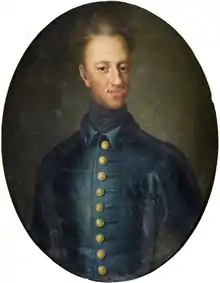
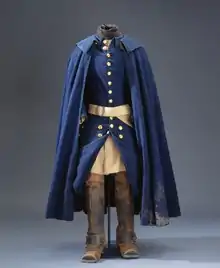
_-_Nationalmuseum_-_18366.tif.jpg.webp)
Charles agreed to leave Constantinople and returned to Swedish Pomerania. He made the journey on horseback, riding across Europe in just fifteen days. He traveled across the Habsburg Kingdom of Hungary to Vienna and arrived at Stralsund. A medal with Charles on horseback, his long hair flying in the wind, was struck in 1714 to commemorate the speedy ride. It reads Was sorget Ihr doch? Gott und Ich leben noch. (What worries you so? God and I live still.).[25]
After five years away, Charles arrived in Sweden to find his homeland at war with Russia, Saxony, Hannover, Great Britain and Denmark. Sweden's western enemies attacked southern and western Sweden while Russian forces traveled across Finland to attack the Stockholm district. For the first time, Sweden found itself in a defensive war. Charles' plan was to attack Denmark by striking at her possessions in Norway. It was hoped that by cutting Denmark's Norwegian supply lines the Danes would be compelled to withdraw their forces from Swedish Scania.
Charles invaded Norway in 1716 with a combined force of 7,000 men. He occupied the capital of Christiania, (modern Oslo), and laid siege to the Akershus fortress there. Due to a lack of heavy siege cannons he was unable to dislodge the Norwegian forces inside. After suffering significant losses of men and materiel, Charles was forced to retreat from the capital on 29 April. In the following mid-May, Charles invaded again, this time striking the border town of Fredrikshald, now Halden, in an attempt to capture the fortress of Fredriksten. The attacking Swedes came under heavy cannon fire from the fortress and were forced to withdraw when the Norwegians set the town of Fredrikshald on fire. Swedish casualties in Fredrikshald were estimated at 500 men. While the siege at Fredrikshald was underway, the Swedish supply fleet was attacked and defeated by Tordenskjold in the Battle of Dynekilen.[26]
In 1718 Charles once more invaded Norway. With a main force of 40,000 men, he again laid siege to the fortress of Fredriksten overlooking the town of Fredrikshald. Charles was shot in the head and killed during the siege, while he was inspecting trenches. The invasion was abandoned, and Charles' body was returned to Sweden. A second force, under Carl Gustaf Armfeldt, marched against Trondheim with 10,000 men but was forced to retreat. In the march that ensued, many of the 5,800 remaining men perished in a severe winter storm.
Death
While in the trenches close to the perimeter of the fortress on 11 December (30 November Old Style), 1718, Charles was struck in the head by a projectile and killed. The shot struck the left side of his skull and exited from the right. The shock of the impact caused the king to grasp his sword with his right hand, and cover the wound with his left hand, leaving his gloves covered in blood.[27]
The definitive circumstances around Charles's death remain unclear. Despite multiple investigations of the battlefield, Charles's skull and his clothes, it is not known where and when he was hit, or whether the shot came from the ranks of the enemy or from his own men.[28] There are several hypotheses as to how Charles died, though none can be given with any certainty. Although there were many people around the king at the time of his death, there were no known witnesses to the actual moment he was struck. A likely explanation has been that Charles was killed by the Dano-Norwegians as he was within easy reach of their guns.[29] There are two possibilities that are usually cited: that he was killed by a musket shot, or that he was killed by grapeshot from the nearby fortress.
More sinister theories claim he was assassinated: One is that the killer was a Swedish compatriot and asserts that enemy guns were not firing at the time Charles was struck.[29] Suspects in this claim range from a nearby soldier tired of the siege and wanting to put an end to the war, to an assassin hired by Charles's own brother-in-law, who profited from the event by subsequently taking the throne himself as Frederick I of Sweden, that person being Frederick's aide-de-camp, André Sicre. Sicre confessed during what was claimed to be a state of delirium brought on by fever but later recanted.[29] It has also been suspected that a plot to kill Charles may have been put in place by a group of wealthy Swedes who would benefit from the blocking of a 17% wealth tax that Charles intended to introduce.[29] In the Varberg Fortress museum there is a display with a lead filled brass button - Swedish - that is claimed by some to be the projectile that killed the king.
Another odd account of Charles' death comes from Finnish writer Carl Nordling, who states that the king's surgeon, Melchior Neumann, dreamed the king had told him that he was not shot from the fortress but from "one who came creeping".[29]

Charles's body has been exhumed on three occasions to ascertain the cause of death; in 1746, 1859 and 1917.[29] The 1859 exhumation found that the wound was in accordance with a shot from the Norwegian fort. In 1917, his head was photographed. Peter Englund asserted in his essay "On the death of Charles XII and other murders[31]" that the mortal wound sustained by the King, with a smaller exit wound than entry wound, would be consistent with being hit by a bullet with a speed not exceeding 150 m/s, concluding that Charles was killed by stray grapeshot from the nearby fortress.
Charles was succeeded to the Swedish throne by his sister, Ulrika Eleonora. As his duchy of Palatine Zweibrücken required a male heir, Charles was succeeded as ruler there by his cousin Gustav Leopold. Georg Heinrich von Görtz, Charles' minister, was beheaded in 1719.
Personal life
Charles never married and fathered no children of whom historians are aware. In his youth he was particularly encouraged to find a suitable spouse in order to secure the succession, but he would frequently avoid the subject of sex and marriage. Possible candidates included Princess Sophia Hedwig of Denmark and Princess Maria Elisabeth of Holstein-Gottorp – but of the latter he pleaded that he could never wed someone "as ugly as Satan and with such a devilish big mouth".[32] Instead he made it clear that he would marry only someone of his own choice, and for love rather than dynastic pressures. His lack of mistresses may have been due to a strong religious faith.[33] Charles himself suggested in conversation with Axel Löwen that he actively resisted any match until peace could be secured[34] and was in some sense "married" to the military life.[35][36] But that he was "chaste" occasioned speculation in his lifetime. Rumours that he was a hermaphrodite were quelled in 1917 when his coffin was opened and he was shown to have suffered no physical irregularities.[37]
_-_Nationalmuseum_-_17950.tif.jpg.webp)
In his conversations with Löwen, he also stated that he did not lack taste for beautiful women, but that he held in his sexual desires for fear that they would get out of control if unchecked, and that if he committed to something like that, it would be forever.[34][38] Some historians suggest that he resisted a marriage with Denmark which could have caused a family rift between those who dynastically favoured Holstein-Gottorp.[39] Historians such as Blanning and Montefiore believe he was in fact homosexual.[40][41] Certainly a letter from Reuterholm suggested that Charles had indicated a closeness to the Elector Prince of Saxony, Maximilian Emanuel of Württemberg-Winnental, whom Charles described as "very pretty". But writing in the 1960s, Hatton argues that Wurttemberg was very much heterosexual and the relationship is just as likely to have been that of teacher-pupil – suggesting instead that Charles simply had an interest in the opposite sex never consummated.[37]
Legacy
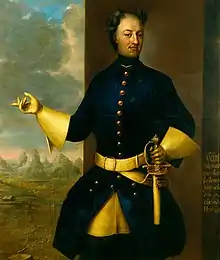
Exceptional for abstaining from alcohol and sex, he felt most comfortable during warfare. Contemporaries report of his seemingly inhuman tolerance for pain and his utter lack of emotion. His brilliant campaigning and startling victories brought his country to the pinnacle of her prestige and power, although the Great Northern War resulted in Sweden's defeat and the end of her empire within years of his own death.
Charles' death marked the end of autocratic kingship in Sweden, and the subsequent Age of Liberty saw a shift of power from the monarch to the parliament of the estates.[42] Historians of the late 18th and early 19th centuries viewed Charles' death as the result of an aristocratic plot, and Gustav IV Adolf, the king who refused to settle with Napoleon Bonaparte, "identified himself with Charles as a type of righteous man struggling with iniquity" (Roberts).[43] Throughout the 19th century's romantic nationalism Charles XII was viewed as a national hero. He was idealized as a heroic, virtuous young warrior king, and his fight against Peter the Great was associated with the contemporary Swedish-Russian enmity.[44] Examples of the romantic hero idolatry of Charles XII in several genres are Esaias Tegnér's song Kung Karl, den unge hjälte (1818), Johan Peter Molin's statue[44] in Stockholm's Kungsträdgården (unveiled on 30 November 1868, the 150th anniversary of Charles' death)[45] and Gustaf Cederström's painting Karl XII:s likfärd ("Funeral procession of Charles XII", 1878).[46] The date of Charles' death was chosen by a student association in Lund for annual torch marches beginning in 1853.[47]
In 1901, August Strindberg in his play Karl XII broke with the heroization practice, showing an introverted Charles XII in conflict with his impoverished subjects.[48] In the so-called Strindberg feud (1910–1912), his response to the "Swedish cult of Charles XII" (Steene)[49] was that Charles had been "Sweden's ruin, the great offender, a ruffian, the rowdies' idol, a counterfeiter."[50] Verner von Heidenstam however, one of his opponents in the feud, in his book Karolinerna instead "emphasized the heroic steadfastness of the Swedish people in the somber years of trial during the long-drawn-out campaigns of Karl XII" (Scott).[51]
In the 1930s, the Swedish Nazis held celebrations on the date of Charles XII's death, and shortly before the outbreak of World War II, Adolf Hitler received from Sweden a sculpture of the king at his birthday.[52] In the late 20th century, Swedish nationalists and neo-Nazis had again used 30 November as a date for their ceremonies, however these were regularly interrupted by larger counter-demonstrations and were abandoned.[53]
Scientific contributions
Apart from being a monarch, the King's interests included mathematics, and anything that would be beneficial to his warlike purposes. He is credited with having invented an octal numeral system, which he considered more suitable for war purposes because all the boxes used for materials such as gunpowder were cubic. According to a report by contemporary scientist Emanuel Swedenborg, the King had sketched a model of his thoughts on a piece of paper and handed it to him at their meeting in Lund in 1716. The paper was reportedly still in existence a hundred years later but has since been lost.
Literature
Charles fascinated many in his time. In 1731, Voltaire wrote a biography of Charles XII, History of Charles XII. Voltaire portrays the Swedish king in a positive light, against the brutal nature of Peter the Great.[54] Samuel Johnson, a devoted anti-militarian, wrote in his poem "The Vanity of Human Wishes":
On what Foundation stands the warrior's pride,
How just his hopes let Swedish Charles decide;
A frame of adamant, a soul of fire,
No dangers fright him, and no labours tire;
O'er love, o'er fear, extends his wide domain,
Unconquered lord of pleasure and of pain;
No joys to him pacific sceptres yield;
War sounds the trump, he rushes to the field;
Behold surrounding kings their power to combine,
And one capitulate, and one resign;
Peace courts his hand, but spreads her charms in vain;
"Think nothing gained", he cries, "till nought remain,
On Moscow's walls till Gothic standards fly,
And all be mine beneath the polar sky."
The march begins in military state,
And nations on his eye suspended wait;
Stern Famine guards the solitary coast,
And Winter barricades the realms of Frost;
He comes, not want and cold his course delay; -
Hide, blushing Glory, hide Pultowa's day:
The vanquished hero leaves his broken bands,
And shows his miseries in distant lands;
Condemned a needy supplicant to wait,
While ladies interpose, and slaves debate.
But did not Chance at length her error mend?
Did no subverted empire mark his end?
Did rival monarchs give the fatal wound?
Or hostile millions press him to the ground?
His fall was destined to a barren strand,
A petty fortress, and a dubious hand;
He left the name, at which the world grew pale,
To point a moral or adorn a tale.
Swedish author Frans G. Bengtsson and Professor Ragnhild Hatton have written biographies of Charles XII of Sweden.[55][56][57]
Charles XII figures quite prominently in Robert Massie's magnum opus Peter the Great.[58]
Ancestors
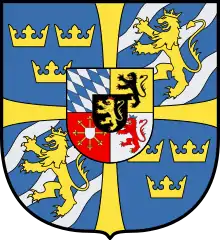
In popular culture
August Strindberg's 1901 play Carl XII is about him.
The 1925 Swedish film Charles XII was a silent epic portraying his reign. In the 1983 comedy film Kalabaliken i Bender, Charles XII is portrayed by Gösta Ekman. In 2007, Oleg Ryaskov again portrayed Charles XII (Eduard Flerov) in the Russian drama The Sovereign's Servant.
Charles XII appears in the absurdist comedy A Pigeon Sat on a Branch Reflecting on Existence (2014), in which his army passes a modern-day cafe on their way to, and retreating from, the Battle of Poltava. He is played by Viktor Gyllenberg.[59][60]
The Swedish power metal band Sabaton wrote an album named after him, which includes several songs about his life.[61][62]
See also
Notes
- Demirbaş, the Turkish word for fixed asset, is literally "ironhead" (demir as "iron", baş as "head"), which is the reason why this nickname has often been translated as Ironhead Charles. However, it should be said, that this translation is wrong and does not reflect the truth. Although, written separately, demir baş really means "iron head", the whole word demirbaş means "inventory",[20] which reflects Charles' long stay in Ottoman Bender at expenses of sultan's exchequer.
References
- Nordling, Carl O. "The Death of Karl XII". Questia. Questia. Retrieved 29 November 2015.
- "Karl XII (in Swedish)" (PDF). Livrustkammaren. Livrustkammaren Museum. Retrieved 28 April 2016.
- Cronholm, Neander Nicolas (1902). "37". A history of Sweden from the earliest times to the present day. New York.
- Hofberg, Herman; Heurlin, Frithiof; Millqvist, Victor; Rubenson, Olof (1908). Svenskt Biografiskt Handlexikon – Uggleupplagan [Swedish Biographical Dictionary – The Owl Edition] 2nd Edition (In Swedish). Albert Bonniers Förlag. OCLC 49695435.
- "Sweden and Finland. Titles of European hereditary rulers". eurulers.altervista.org. Retrieved 28 April 2016.
- Article Karl in Nordisk familjebok.
- William Pembroke Fetridge (1875). The American Traveller's Guide: Harper's Hand-book for Travellers in Europe and the East : Being a Guide Through Great Britain and Ireland, France, Belgium, Holland, Germany, Italy, Egypt, Syria, Turkey, Greece, Switzerland, Tyrol, Denmark, Norway, Sweden, Russia, and Spain. p. 829.
- Spencer C. Tucker, ed. (2015). Wars That Changed History: 50 of the World's Greatest Conflicts. ABC-CLIO. pp. 182–93. ISBN 9781610697866.CS1 maint: extra text: authors list (link)
- Thomas Derry, History of Scandinavia: Norway, Sweden, Denmark, Finland, and Iceland (2000), p. 154.
- Richard Cavendish, "The Battle of Narva." History Today 50#11 (2000): 50+.
- Renata Tyszczuk (2007). The Story of an Architect King: Stanislas Leszczynski in Lorraine 1737-1766. Peter Lang. p. 34. ISBN 9783039103249.
- Karoliner by Alf Åberg, p. 117.
- Karl XII by Bengt Liljegren, pp. 151 and 163.
- Svenska slagfält, page 280.
- Svenska folkets underbara öden, book four by Carl Grimberg, about the numbers of Mazepa's army.
- Bra Böckers Lexikon, the article of Karl XII.
- Kalevi Jaakko Holsti (1991). Peace and War: Armed Conflicts and International Order, 1648-1989. p. 69. ISBN 9780521399296.
- Dominic Lieven (2006). The Cambridge History of Russia: Volume 2, Imperial Russia, 1689-1917. p. 29. ISBN 9780521815291.
- Herman Lindquist (in Swedish): Historian om Sverige. Storhet och Fall. (History of Sweden. Greatness and fall) 91-7263-092-2 (2000) Nordstedts förlag, Stockholm
- "Yandex.Transletor: DEMİRBAŞ".
- "SWEDEN, THE OTTOMAN EMPIRE AND THE CRIMEAN TARTARS, c 1580 – 1714 – THE REALPOLITIK OF A CHRISTIAN KINGDOM". Världsinbördeskriget. Wordpress. Retrieved 28 April 2016.
- Zetterberg, Seppo (1987). Suomen historian pikkujättiläinen. p. 265. ISBN 978-951-0-14253-0.
- R.M. Hatton, Charles XII of Sweden, London, 1968; Seppo Zetterberg et al. (eds.), A Small Giant (Compendium) of the Finnish History / Suomen historian pikkujättiläinen. 2nd edition. Helsinki, Finland, 2003)
- "Redan Karl XII godkände muslimska gudstjänster". svt.se (in Swedish). 23 September 2015.
- Wilson, Peter Hamish. German armies. War and German politics, 1648-1806. Warfare and history. p. 140. ISBN 1-85728-106-3.
- "Karl XIIs felttog i Norge". nb.no.
- "Archived copy". Archived from the original on 5 October 2013. Retrieved 10 August 2013.CS1 maint: archived copy as title (link)
- Lindqvist, Herman (29 November 2009). "Karl XII:s död ger inte forskarna någon ro". Aftonbladet.
- Mike Dash (17 September 2012). "Past Imperfect". Smithsonian Magazine.
- Dash, Mike. "The Blazing Career and Mysterious Death of "The Swedish Meteor"". Smithsonian. Retrieved 24 December 2017.
- Förflutenhetens landskap ("The Landscape of Times Past") (1991), collection of essays, pp. 126–129.
- R. M. Hatton, Charles XII of Sweden, 1968, p. 89.
- Frans Bengtsson, The Life of Charles XII, p. 38.
- Liljegren, Karl XII: en biografi.
- R. M. Hatton, Charles XII of Sweden, 1968, p. 210.
- Frans Bengtsson, The Life of Charles XII, p. 469.
- R. M. Hatton, Charles XII of Sweden, 1968, p. 219.
- R. M. Hatton, Charles XII of Sweden, 1968, p. 220.
- Byron Nordstrom, Dictionary of Scandinavian History, p. 317.
- Tim Blanning, Frederick the Great, 2015, p. 152.
- Simon Sebag Montefiore, The Romanovs: 1613-1918, 2016, p. 451.
- Massengale, James (1996). "The Enlightenment and the Gustavian Age". In Warme, Lars G. (ed.). A History of Swedish literature. University of Nebraska Press. pp. 102, 104–105.
- Roberts, Michael (1991). From Oxenstierna to Charles XII. Four Studies. Cambridge University Press. p. 164. Repr. 2003.
- Roberts, Michael (1991). From Oxenstierna to Charles XII. Four Studies. Cambridge University Press. pp. 164–165. Repr. 2003.
- Lindblom, Andreas (1946). Sveriges konsthistoria från forntid till nutid. 3. Nordisk rotogravyr. p. 1210.
- Scott, Franklin Daniel (1988). Sweden, the nation's history. SIU Press. p. 560.
- Lööw, Heléne (1998). Nazismen i Sverige 1980–1997. Ordfront.
- Steene, Brigitta (1996). "Strindberg and the transition to Modernism". In Warme, Lars G. (ed.). A History of Swedish literature. University of Nebraska Press. p. 267.
- Steene, Brigitta (1996). "Strindberg and the transition to Modernism". In Warme, Lars G. (ed.). A History of Swedish literature. University of Nebraska Press. p. 271.
- Moers, Gerald (2000). "Im Gemeindewald der Geschichte". In Schöning, Udo (ed.). Internationalität nationaler Literaturen. Wallstein. pp. 285–286, fn. 83.
- Scott, Franklin Daniel (1988). Sweden, the nation's history. SIU Press. p. 551.
- Oredsson, Sverker (2000). "Gustav II. Adolf in Geschichtsschreibung und Kult". In Petersson, Rikke (ed.). Damals, als Schweden eine Großmacht war ... LIT. p. 59.
- "Karl XII-firare ligger lågt i år". DN. 27 November 2011. "Nationalists abandon 'warrior king' anniversary". TheLOcal. 28 November 2011. On the use of Charles XII by nationalists and Nazis in general "Om den 30 november". Peter Englund, in Expressen 30 November 1994. Archived from the original on 21 April 2012.
- Voltaire (1740). The History of Charles XII. King of Sweden ... Seventh edition... p. 1.
- Bengtsson, Frans G. Karl XII:s Levnad. Norstedts. ISBN 9789119418326.
- Hatton, Ragnhild Marie (1968). Charles XII of Sweden. London.
- Voltaire (1731). History of Charles XII, King of Sweden.
- Massie, Robert K. (October 1981). Peter the Great: His Life and World. New York City: Ballantine Books. pp. Part 3–4. ISBN 0-345-29806-3.
- "Cinema Scope | A Pigeon Sat on a Branch Reflecting on Existence (Roy Andersson, Sweden)". cinema-scope.com.
- "A Pigeon Sat on a Branch Reflecting on Existence review: 'heaven'". 23 April 2015 – via www.telegraph.co.uk.
- NewEngland7, kluseba, gasmask_colostomy, Midnight Rambler, Braindead Binky, Napero, MetalGuard, hells_unicorn, Immortally_Insane, Lord_Lexy (25 May 2012). "Sabaton - Carolus Rex - Reviews - Encyclopaedia Metallum: The Metal Archives". Metal Archives. Retrieved 17 January 2020.CS1 maint: multiple names: authors list (link)
- Sundström, Pär (7 December 2018). "Pär Sundström interview - Carolus Rex - Part 2/3". YouTube (Interview).
Further reading
- Bain, Robert Nisbet. Charles XII and the Collapse of the Swedish Empire, 1682-1719 (1899) online.
- Bengtsson, F. G. The Life of Charles XII, King of Sweden, 1697-1718 (1960). also published as The sword does not jest. The heroic life of King Charles XII of Sweden (St. Martin's Press 1960).
- Browning, Oscar. Charles XII of Sweden (London: Hurst and Blackett,1899).
- Fielding, Henry (Translator), The Military History of Charles XII. King of Sweden, Written by the Express Order of His Majesty, by M. Gustavus Adlerfeld, to Which Is Added, an Exact Account of the Battle of Pultowa, Illustrated with Plans in Three Volumes (London: printed for J. and P. Knapton; J. Hodges; A. Millar; and J. Nourse, 1740). Reprinted by Gale Ecco, Print Editions (2010).
- Gade, John (Translator), Charles the Twelfth King of Sweden: Translated from the manuscript of Carl Gustafson Klingspor (Boston: Houghton Mifflin, 1916). Reprinted by Merkaba Press (2017).
- Glaeser, Michael. By Defeating My Enemies: Charles XII of Sweden and the Great Northern War, 1682-1721 (Helion & Co Ltd, 2020).
- Hattendorf, J. B., Åsa Karlsson, Margriet Lacy-Bruijn, Augustus J. Veenendaal, Jr., and Rolof van Hövell tot Westerflier, Charles XII: Warrior King (Rotterdam: Karwansaray, 2018).
- Hatton, R. M. Charles XII of Sweden (1968).
- Hone, Michael. Charles XII of Sweden: Versus Peter the Great of Russia (Createspace Independent Pub., 2016).
- Peterson, Gary Dean. Warrior kings of Sweden: the rise of an empire in the sixteenth and seventeenth centuries (McFarland, 2007).
- Voltaire, Francois Marie Arouet de. History of Charles XII, King of Sweden (translated by W.H. Dilworth, 1760). Reprinted by True World of Books (2020).
External links
 Media related to Charles XII of Sweden at Wikimedia Commons
Media related to Charles XII of Sweden at Wikimedia Commons
| Wikisource has the text of the 1911 Encyclopædia Britannica article Charles XII.. |
- The Swedish Meteor: the blazing career and mysterious death of Charles XII Smithsonian summary of assassination theories.
- Charles XII: on the centenary of his death 1818 The original Swedish text by Esaias Tegner, as well as parallel translations by J.E.D.Bethune (1848) and Charles Harrison-Wallace (1998) and a comment by the latter.
- The Great Northern War and Charles XII
- Charles XII and his Life and Death (in Swedish)
- BBC News item: Who killed Sweden's Warrior King?
- Timeline of 1700–1720 in Sweden
- . . 1914.
- . New International Encyclopedia. 1905.
- . The American Cyclopædia. 1879.
Charles XII of Sweden Cadet branch of the House of Wittelsbach Born: 17 June 1682 Died: 30 November 1718 | ||
| Regnal titles | ||
|---|---|---|
| Preceded by Charles XI |
King of Sweden Duke of Bremen and Verden 1697–1718 |
Succeeded by Ulrika Eleonora |
| Duke of Palatine Zweibrücken 1697–1718 |
Succeeded by Gustav Samuel Leopold | |
